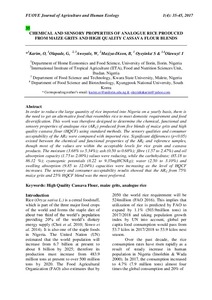| dc.contributor.author | Karim, O.R. |
| dc.contributor.author | Olapade, G. |
| dc.contributor.author | Awoyale, W. |
| dc.contributor.author | Maziya-Dixon, B. |
| dc.contributor.author | Oyeyinka, S. |
| dc.contributor.author | Olawuyi, I. |
| dc.date.accessioned | 2021-01-19T15:14:26Z |
| dc.date.available | 2021-01-19T15:14:26Z |
| dc.date.issued | 2017 |
| dc.identifier.citation | Karim, O.R., Olapade, G., Awoyale, W., Maziya-Dixon, B., Oyeyinka, S. & Olawuyi, I. (2017). Chemical and sensory properties of analogue rice produced from maize grits and high quality cassava flour blends. FUOYE Journal of Agriculture and Human Ecology, 1(4), 35-45. |
| dc.identifier.issn | 2659-1294 |
| dc.identifier.uri | https://hdl.handle.net/20.500.12478/7011 |
| dc.description.abstract | In order to reduce the large quantity of rice imported into Nigeria on a yearly basis, there is the need to get an alternative food that resembles rice to meet domestic requirement and food diversification. This work was therefore designed to determine the chemical, functional and sensory properties of analogue rice (ARC) produced from five blends of maize grits and high quality cassava flour (HQCF) using standard methods. The sensory qualities and consumer acceptability of the ARC were compared with imported rice. Significant differences (p<0.05) existed between the chemical and functional properties of the ARC and reference samples, though most of the values are within the acceptable levels for rice grain and cassava products. The moisture (3.68% to 5.34%); ash (0.50 to 0.68%); fibre (1.57 to 2.47%) and oil absorption capacity (1.75to 2.00%) values were reducing, while the carbohydrate; (85.18 to 86.12 %); cyanogenic potentials (8.22 to 9.35mgHCN/kg); water (2.50 to 3.10%) and swelling absorption (9.85 to 12.04%) capacities were increasing as the level of HQCF increases. The sensory and consumer acceptability results showed that the ARC from 75% maize grits and 25% HQCF blend was the most preferred. |
| dc.format.extent | 35-45 |
| dc.language.iso | en |
| dc.subject | Cassava |
| dc.subject | Flours |
| dc.subject | Maize |
| dc.subject | Rice |
| dc.subject | Foods |
| dc.subject | Diversification |
| dc.subject | Chemical Composition |
| dc.subject | Chemicophysical Properties |
| dc.subject | organoleptic properties |
| dc.title | Chemical and sensory properties of analogue rice produced from maize grits and high quality cassava flour blends |
| dc.type | Journal Article |
| cg.contributor.crp | Agriculture for Nutrition and Health |
| cg.contributor.crp | Maize |
| cg.contributor.crp | Roots, Tubers and Bananas |
| cg.contributor.affiliation | University of Ilorin |
| cg.contributor.affiliation | International Institute of Tropical Agriculture |
| cg.contributor.affiliation | Kwara State University |
| cg.contributor.affiliation | Kyungpook National University, South Korea |
| cg.coverage.region | Africa |
| cg.coverage.region | West Africa |
| cg.coverage.country | Nigeria |
| cg.coverage.hub | Headquarters and Western Africa Hub |
| cg.researchtheme | Nutrition and Human Health |
| cg.identifier.bibtexciteid | KARIM:2017a |
| cg.authorship.types | CGIAR and developing country institute |
| cg.iitasubject | Agronomy |
| cg.iitasubject | Biodiversity |
| cg.iitasubject | Cassava |
| cg.iitasubject | Food Science |
| cg.iitasubject | Food Security |
| cg.iitasubject | Food Systems |
| cg.iitasubject | Maize |
| cg.iitasubject | Nutrition |
| cg.iitasubject | Plant Production |
| cg.journal | FUOYE Journal of Agriculture and Human Ecology |
| cg.accessibilitystatus | Limited Access |
| cg.reviewstatus | Peer Review |
| cg.usagerightslicense | Copyrighted; all rights reserved |
| cg.targetaudience | Scientists |
| cg.iitaauthor.identifier | Wasiu Awoyale: 0000-0002-3635-1414 |
| cg.iitaauthor.identifier | Busie Maziya-Dixon: 0000-0003-2014-2201 |
| cg.futureupdate.required | No |

